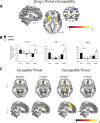Dissociated neural effects of cortisol depending on threat escapability
- PMID: 26248899
- PMCID: PMC6869485
- DOI: 10.1002/hbm.22918
Dissociated neural effects of cortisol depending on threat escapability
Abstract
Evolution has provided us with a highly flexible neuroendocrine threat system which, depending on threat imminence, switches between active escape and passive freezing. Cortisol, the "stress-hormone", is thought to play an important role in both fear behaviors, but the exact mechanisms are not understood. Using pharmacological functional magnetic resonance imaging we investigated how cortisol modulates the brain's fear systems when humans are under virtual-predator attack. We show dissociated neural effects of cortisol depending on whether escape from threat is possible. During inescapable threat cortisol reduces fear-related midbrain activity, whereas in anticipation of active escape cortisol boosts activity in the frontal salience network (insula and anterior cingulate cortex), which is involved in autonomic control, visceral perception and motivated action. Our findings suggest that cortisol adjusts the human neural threat system from passive fear to active escape, which illuminates the hormone's crucial role in the adaptive flexibility of fear behaviors.
Keywords: cortisol; salience network; threat escape.
© 2015 Wiley Periodicals, Inc.
Figures




Similar articles
-
From threat to fear: the neural organization of defensive fear systems in humans.J Neurosci. 2009 Sep 30;29(39):12236-43. doi: 10.1523/JNEUROSCI.2378-09.2009. J Neurosci. 2009. PMID: 19793982 Free PMC article.
-
When fear is near: threat imminence elicits prefrontal-periaqueductal gray shifts in humans.Science. 2007 Aug 24;317(5841):1079-83. doi: 10.1126/science.1144298. Science. 2007. PMID: 17717184 Free PMC article.
-
Neural Underpinnings of Cortisol Effects on Fear Extinction.Neuropsychopharmacology. 2018 Jan;43(2):384-392. doi: 10.1038/npp.2017.227. Epub 2017 Sep 26. Neuropsychopharmacology. 2018. PMID: 28948980 Free PMC article. Clinical Trial.
-
Cortisol before extinction generalization alters its neural correlates during retrieval.Psychoneuroendocrinology. 2022 Feb;136:105607. doi: 10.1016/j.psyneuen.2021.105607. Epub 2021 Nov 27. Psychoneuroendocrinology. 2022. PMID: 34864329
-
Magnetic resonance imaging predictors of psychotherapy treatment response in post-traumatic stress disorder: A role for the salience network.Psychiatry Res. 2019 Jul;277:52-57. doi: 10.1016/j.psychres.2019.02.005. Epub 2019 Feb 2. Psychiatry Res. 2019. PMID: 30755338 Review.
Cited by
-
Associations between brain activity and endogenous and exogenous cortisol - A systematic review.Psychoneuroendocrinology. 2020 Oct;120:104775. doi: 10.1016/j.psyneuen.2020.104775. Epub 2020 Jun 18. Psychoneuroendocrinology. 2020. PMID: 32592873 Free PMC article.
-
Understanding Brain Mechanisms of Reactive Aggression.Curr Psychiatry Rep. 2020 Nov 12;22(12):81. doi: 10.1007/s11920-020-01208-6. Curr Psychiatry Rep. 2020. PMID: 33180230 Free PMC article. Review.
-
Neural responses in the pain matrix when observing pain of others are unaffected by testosterone administration in women.Exp Brain Res. 2020 Mar;238(3):751-759. doi: 10.1007/s00221-020-05749-3. Epub 2020 Feb 21. Exp Brain Res. 2020. PMID: 32086551 Free PMC article.
-
Anticipated Attack Slows Responses in a Cued Virtual Attack Emotional Sternberg Task.Eur J Psychol. 2021 Feb 26;17(1):31-43. doi: 10.5964/ejop.1896. eCollection 2021 Feb. Eur J Psychol. 2021. PMID: 33737972 Free PMC article.
-
Controllability over stressor decreases responses in key threat-related brain areas.Commun Biol. 2021 Jan 5;4(1):42. doi: 10.1038/s42003-020-01537-5. Commun Biol. 2021. PMID: 33402686 Free PMC article.
References
-
- Amat J, Baratta MV, Paul E, Bland ST, Watkins LR, Maier SF (2005): Medial prefrontal cortex determines how stressor controllability affects behavior and dorsal raphe nucleus. Nat Neurosci 8:365–371. - PubMed
-
- Blanchard DC, Griebel G, Blanchard RJ (2001): Mouse defensive behaviors: pharmacological and behavioral assays for anxiety and panic. Neurosci Biobehav Rev 25:205–218. - PubMed
-
- Böhnke R, Bertsch K, Kruk MR, Richter S, Naumann E (2010): Exogenous cortisol enhances aggressive behavior in females, but not in males. Psychoneuroendocrinology 35:1034–1044. - PubMed
-
- Buchanan TW, Brechtel A, Sollers JJ, Lovallo WR (2001): Exogenous cortisol exerts effects on the startle reflex independent of emotional modulation. Pharmacol Biochem Behav 68:203–210. - PubMed
Publication types
MeSH terms
Substances
LinkOut - more resources
Full Text Sources
Other Literature Sources

